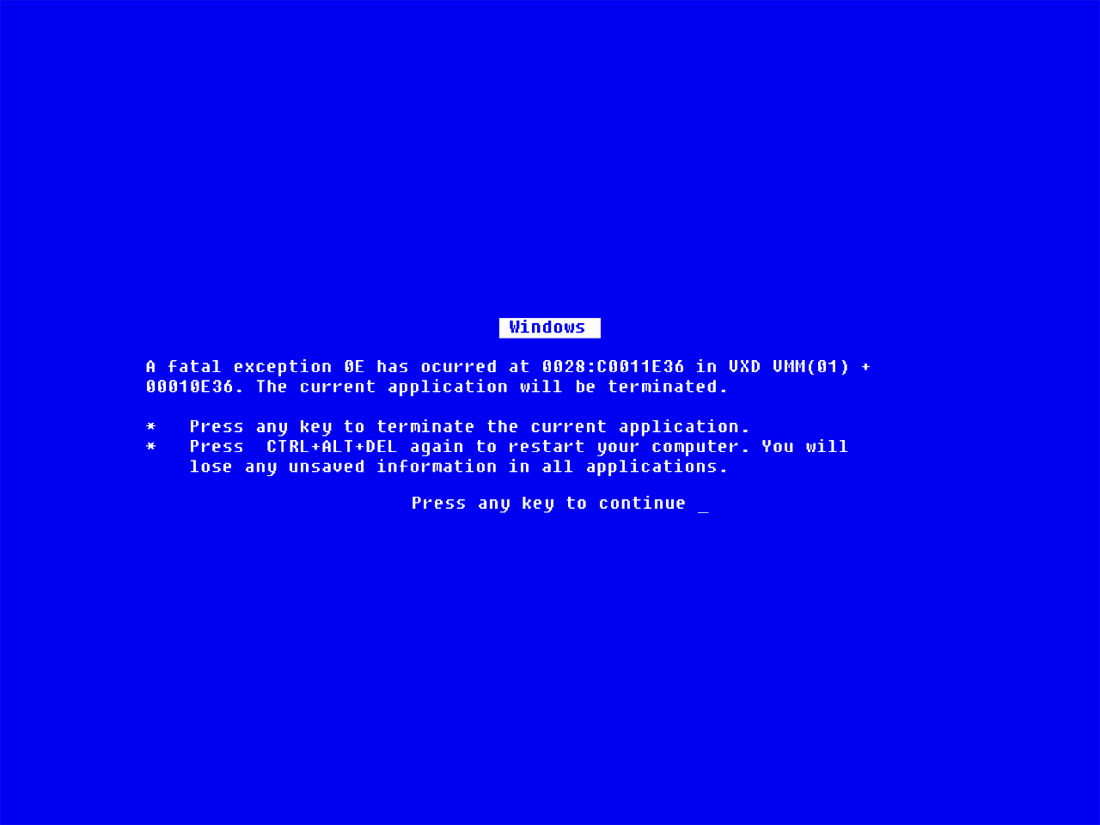
Auto polo | Library of Congress | Public Domain
In an economic system that is governed by efficiency, committing an error is seen as a weakness. However, the ideology behind innovation and start-ups advocates that making mistakes is necessary for success. So, to what point are errors tolerated in digital culture? From a computer that hangs because of a wrongly programmed algorithm to the myth of failure in Silicon Valley. A review of the forms, ideas and effects of dropped clangers in today’s society.
The festival Ars Electronica, one of the most important art and new technologies events in the world, titled its 2018 edition “Error. The art of imperfection“. It devoted two exhibitions and a series of lectures to the mistake as a fundamental component of scientific innovation and human progress, as well as its darker side: the failure of the Internet as a project of freedom. An ambivalent view that is not only typical of this era, but that takes on specific appearances in the information society. Below, we review some of the forms of digital errors, in the personal, artistic, social and business realms.
The aesthetic of frustration
Technology forms part of all the spheres of everyday life, at least in societies with a greater penetration of the Internet. Mobile devices and geolocation have made possible perpetual connection, blurring the limits between the physical and the virtual. Probably for this reason, the everyday technological fail –the Wi-Fi that doesn’t connect, the program that crashes, etc.– alters the flow of things and generates diverse degrees of frustration and anxiety. Computer failure is a reminder, in the words of electronic musician Kim Cascone, that “our control of technology is an illusion, and revealing digital tools to be only as perfect, precise, and efficient as the humans who build them”.
However small its repercussions are, the failure of a system or program is relevant as soon as it makes manifest the invisible role of technology. Although momentary, it is sufficient to evidence human-machine mediation, which design endeavours to make imperceptible.
Within the framework of digital culture, over two decades ago this phenomenon generated its own aesthetic, “glitch art”, in which errors are used intentionally to generate images or sounds. Studies on this art form have indicated three possible interpretations. The first, the most politicised, understands it as a critical resistance strategy in the face of global capitalism. Under this perspective, the glitch challenges the very idea of technological progress. The second, considers it an artistic practice that democratises the relationship between producer and receiver on two levels: by demystifying the technical perfection of the artists, and also by forcing the spectator to decode the experience of the fault. Finally, a third interpretation opts for a more playful meaning, understanding that the glitch is experimentation, play and participation in relation with technology, and in this sense it would have more of a reparative than a critical function.
System failure
Being Wrong: Adventures in the Margin of Error is an entertaining book by Kathryn Schulz that analyses in exhaustive detail the experience of getting it wrong. Although the journalist concludes that this must be understood as an opportunity rather than an ordeal, she recognises that its importance is not the same if someone forgets where their car keys are as – the analogy is hers – as if someone believes that another country possesses weapons of mass destruction. These are “consequences so dramatically dissimilar” writes Schulz, “that we might reasonably wonder if the errors that led to them can have anything in common”.
Similarly, one can enjoy glitch art when it exploits small everyday incidents, but it is not the same when a computer system fails as it executes a word processor as it is when controlling the direction of a driverless car or the decisions of a combat drone. In spheres such as these, the perception of the digital error is more worrying and awakens some of the most deep-rooted fears in our culture: runaway science, Doctor Frankenstein, the mediaeval Golem.
However, the current course being taken by progress does not need deviations to generate misgivings, and in fact the very promise of perfection offered by the digital world is sufficiently worrying in itself. A good example of this is the automation of work or, to put it another way, the machine that makes no mistakes. Although its real impact on the destruction of jobs is not clear, its expansion in favour of efficiency feeds the idea that technology can substitute rather than merely strengthen some human capabilities. Another, perhaps more troubling example, is the Chinese social credit system, which uses artificial intelligence for the mass surveillance of citizens and the sanctioning of behaviours considered antisocial, from crossing a red traffic light to criticizing the Government on social media.
In both cases, automation and surveillance, technology supresses and penalises what, from the viewpoint of the engineer or legislator, is unproductive or antisocial; the labour or social error, that which violates the rule. There is a search for perfection that philosopher Byung-Chul Han has christened in aesthetic terms as digital beauty, “a smooth space of the same, which does not permit anything alien, any alterity, to enter”. An experience that for this South Korean writer defines the current era and is reflected as much by the sculptures of Jeff Koons as by Brazilian waxing and the iPhone.

Blue Screen of Death | Wikipedia | Public Domain
Fail fast, fail often
The design of these “polished and smooth”, error-free experiences, depends largely on the decisions made at the world’s main technological hubs, with Silicon Valley at the forefront. It is precisely in this area where one of the most repeated mantras of the culture of innovation and entrepreneurship blossomed: the belief that not only should failure not be avoided, but that it should be celebrated as part of the rites of passage on the road towards success.
The origins of this idea are uncertain, but undoubtedly they are related to two aspects. Firstly, the American legend of the business entrepreneur who triumphs despite adversity, often rising from his own ashes. Icons of popular culture such as Walt Disney and Henry Ford are examples of this, as well as technology personalities such as Bill Gates and Steve Jobs. Secondly, in software development, the idea of the product that works from the very first day does not exist, and it is customary to continue developing new features without resolving the errors, which are progressively eliminated in more advanced phases of the project. The global expansion of the “start-up” model has exported this conception, speeding up the processes of traditional structures, making them more flexible and, in the best of cases, more democratic.
However, an increasing number of voices consider as deceitful this founding myth of Silicon Valley, which has materialised in formulas such as ‘Fail fast, fail often’. Even professionals of the business world such as investor Mark Suster, argued some years ago that this idea was “wrong, irresponsible, unethical and heartless”, because failure does not have much of the epic in it for people who invest thousands of dollars in a project, even more so when these are a friend’s or a relative’s savings. “Fail fast? How does your brother-in-law feel about that?” Suster ironized. A critical focus which is coupled with the undeniable predominance of young white males from elite universities at the heart of these companies, reflecting who has access to the necessary capital in order to fail comfortably.
Even the start-up culture shows its own contradictions in this respect. A good example of this is so-called “growth hacking”, one of the most recent trends in the entrepreneurship world, which promotes ways of accelerating growth in the least expensive way possible. This includes guerrilla marketing techniques, but can lead to others of dubious trustworthiness such as falsifying the number of users of a service in order to attract investors. Faking success to avoid failure.
Human at the end of the day
One thousand two hundred years before the “cogito, ergo sum”, of René Descartes, Agustine of Hippo wrote “fallor ergo sum”, in other words, “I err, therefore I am”. For the philosopher, the error is not an accident that must be avoided at all costs, but the very essence of being human. Ultimately, who does not get it wrong sometimes? Probably for this reason, the promise of perfection offered by the digital world inspires misgivings, since it is contrary to humanity in the most fundamental way.
Glitch art and the fear of the course being taken by technology share, in this sense, a critical attitude towards the threat of perfection, towards the inhuman. An option that takes on a contradictory aspect in Silicon Valley, as it is mainly based on a model of techno-scientific progress —that inevitably passes through experimenting and making mistakes— but, at the same time, embodies the core of the new capitalism and is therefore governed by efficiency and competitiveness. An ambivalence towards failure that is not only typical of technology companies, but that given its pre-eminence in the digital economy, is important for understanding error in the culture of today.



Fernando | 20 November 2018
Interesante artículo, siempre me ha llamado mucho la atención el arte del error en cualquier disciplina, excepto en la que te toca el bolsillo y la de tus mecenas. En la parte creativa y de búsqueda de ese algo si que le encuentro sentido; de hecho siempre cuento con que aparezca ese error divino en el proceso de trabajo cuando estoy diseñando un Logotipo. Digamos que es otro factor más, quizás emparentado con el azar.
En la parte empresarial y económica sin embargo no tiene tanta gracia, porque cada glitch vale pasta. Y cada ensayo en el terreno emprendedor puede dejarte sin fuerzas para volver a resurgir.
Leave a comment